Spinning Top & Doji Candlestick Pattern: Understand in Detail

Candlesticks are a way of communicating information about how price is moving. As the name suggests, the candlesticks charts resemble a simple candlestick with a body and wick.
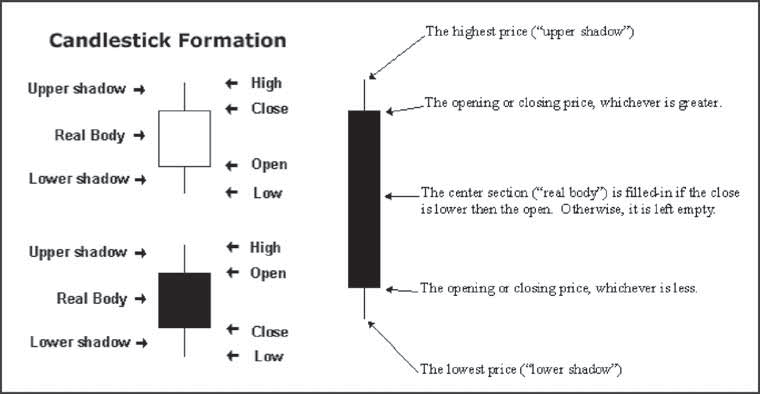
To understand the need and power of candlestick charts, let’s analyse the price action movement of TCS over the last month:
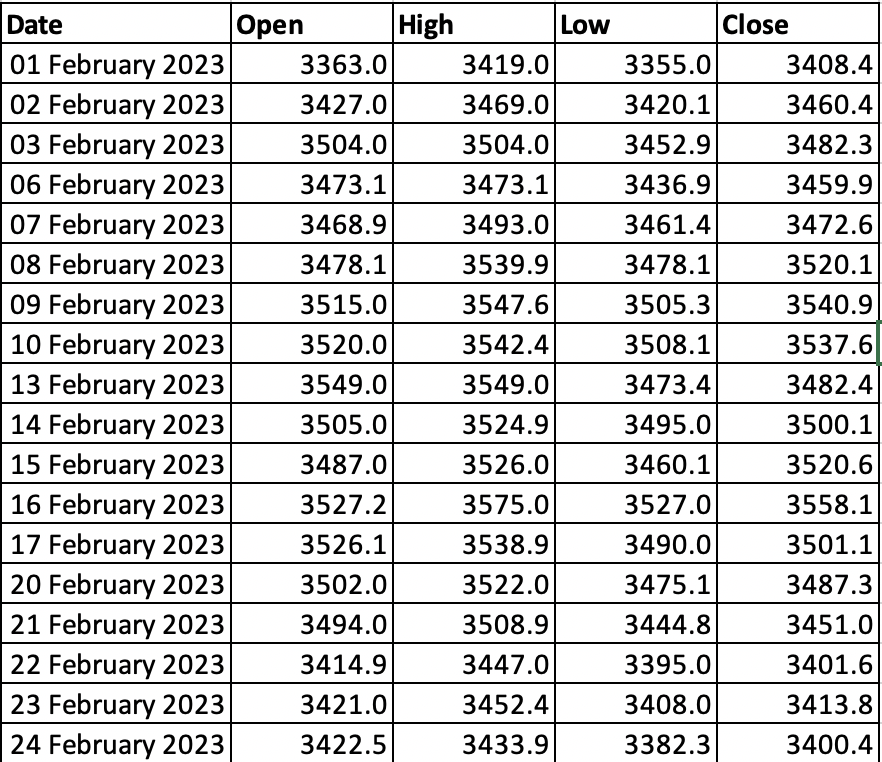
The table above contains the daily reported price movement of TCS from 1st Feb 2023 to 24th Feb 2023.
You have 2 minutes to come to a conclusion by just looking at the above table. What is your analysis? Could you understand the price movement, or could you observe any pattern?
If you are not a maths genius, I would say it would have been very difficult for you to draw any conclusion from all these numbers.
Let’s give it another go, but this time we’ll use the figure below:
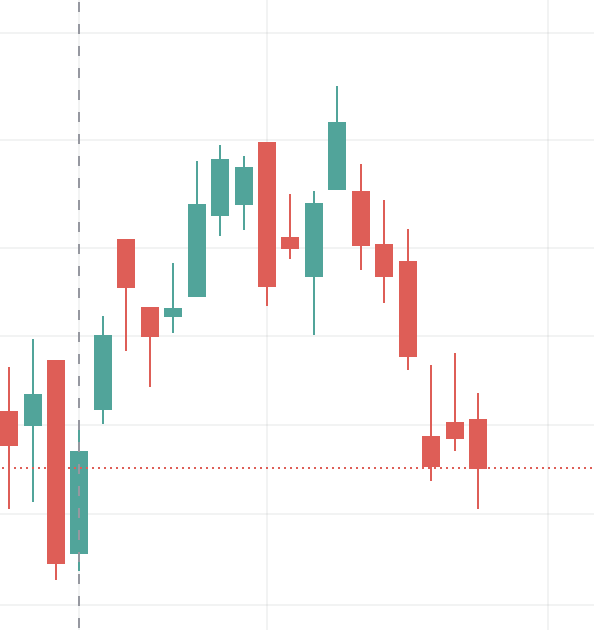
The table and the chart both are representing the same information: Daily Price movement of TCS in Feb’23, but notice how much easier it is to process information when it is in the form of a chart or picture rather than old boring numbers in a table.
Just a look at the chart, you can easily figure out the road map of where the prices have been and get a sense of the trend the prices have been following in the last 1 month.

Let us look at some of the candlestick patterns and their significance:
1. Spinning top
Candlesticks with a long upper wick, long lower wick, and small real body are called spinning tops and typically represents indecision in the market.
Market view
The small body (whether red or green) of the candle indicates little movement from open to close, and the wicks indicate that both bulls and bears were active during the session. Despite the fact that the trading session opened and closed with little change, prices moved considerably higher and lower in the meantime. As a result, there was a standoff because neither buyers nor sellers could gain the upper hand. A spinning top after a long green candlestick denotes the bulls' weakness and hints at a potential trend change or interruption. Similarly, a spinning top after a long red candlestick denotes the bears' weakness and hints at a potential trend change or interruption.
Criteria
- The candlestick must have a small body, with upper and lower wicks of roughly equal length.
- The candlestick must open and close near the same level.
- A substantially shorter body surrounded on both sides by two long candlestick wicks.
- It forms at the peak of an uptrend, the bottom of a downtrend, or in the middle of a trend. It can be a bearish or bullish candle.
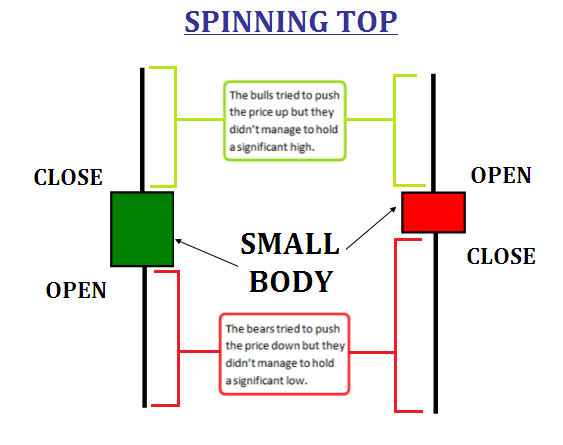
Trade setup
- Since the spinning top pattern indicates indecision, it's important to wait for confirmation before taking any trading action.
- Place a stop-loss below the low of the spinning top pattern if planning to go long or above the high of the pattern if planning to go short.
- If the spinning top pattern forms at a key support or resistance level, look for a break of that level to confirm a potential trend reversal. For example, if the spinning top forms at a key resistance level, a break of that resistance level could signal a bullish breakout.
- The spinning top pattern can also signal a period of consolidation in the market, where the price is trading within a range. In this case, look to trade the range by buying at the support level and selling at the resistance level.
2. Doji
- Doji are a type of candlestick that provides information both on its own and as part of a number of important patterns. However, on its own doji is considered a neutral pattern.
- A doji is like a cross or a plus sign which is formed when the open and close price are nearly equal and the length of the upper and lower wicks vary
- Any bias, whether bullish or bearish, is based on past price action and potential future confirmation.
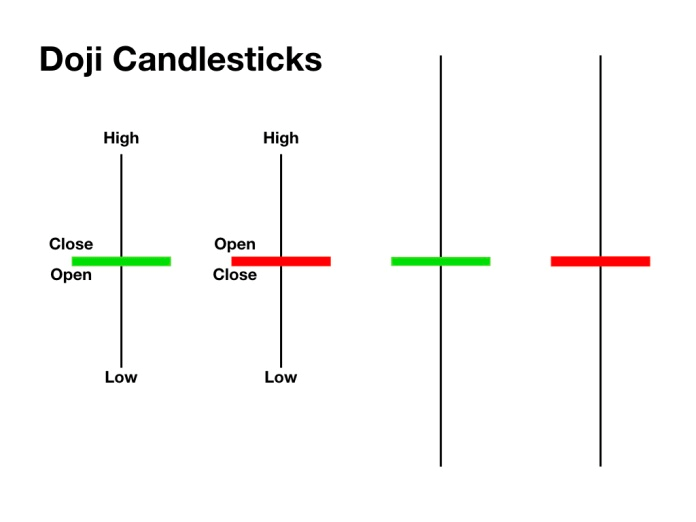
Market view
- Doji represent a tug-of-war or a sense of indecision between buyers and sellers. During the session, the prices move above and below but close at or near the opening level.
- The significance of a doji is determined by the preceding trend or candlesticks.
- Following a long green candlestick, a doji indicates that buying pressure is beginning to wane.
- After a long red candlestick, a doji signals that selling pressure is starting to diminish.
- The reason for the doji’s negative implications in an uptrend is because a doji represents indecision. Indecision among bulls will not maintain the uptrend. If the market has had an extended rally or is overbought, then the formation of a doji could mean the scaffolding of buyers’ support will give way.
- Doji are also valued for their ability to show reversal potential in downtrends. The reason may be that a doji reflects a balance between buying and selling forces.
Criteria
- The open and close of a doji should ideally, but not always, be equal.
- You should give more importance to the essense of the doji candlestick, for example a doji formed among candlesticks with long bodies would be given more importance than a doji formed with small bodies.
Trade setup
- A further downside is required following a doji for bearish confirmation. This may come as a gap down, long red candlestick, or decline below the long green candlestick's open. Traders should be on the lookout for a potential evening doji star after a long green candlestick and doji.
- Bullish confirmation could come from a gap-up, long green candlestick, or advance above the long red candlestick's open. Traders should be on the lookout for a potential morning doji star after a long red candlestick and doji.
- If there are many doji on a particular chart, one should not view the emergence of a new doji in that particular market as a meaningful development. That is why candlestick analysis usually should not use intra-day charts of less than 30 minutes. Less than 30 minutes and many of the candlestick lines become doji or near doji.
To read about candlesticks and technical analysis in detail, click here
FAQs on Spinning Top and Doji Candlestick Pattern
How do you trade a spinning top?
Since the spinning top indicates indecision, it is crucial to wait for a confirmation signal before buying. Set a stop loss and check for potential trend reversal. If the price is within a range, trade by buying at support and selling at resistance.
What does a spinning top candle indicate?
The spinning top candle indicates indecision and uncertainty about the course of an asset in the future. But it can also signify a potential trend reversal of the asset's price in the future.
What is the difference between a Doji and a spinning top?
Even though both of these represent indecision, there is one key difference: their Bodies. A Doji has a small real body and small upper and lower shadows, while a spinning top has long upper and lower shadows.
Is Doji bullish or bearish?
Since Dojis normally represents an indecisive market, it is considered to be a neutral pattern that neither hints at an uptrend nor a downtrend.
Is a Doji a reversal pattern?
Dojis are a neutral indicator, and they provide very little information. And since they are rare, they are not considered reliable for spotting reversals.
 Top Mutual Funds
Top Mutual Funds








COMMENT (0)